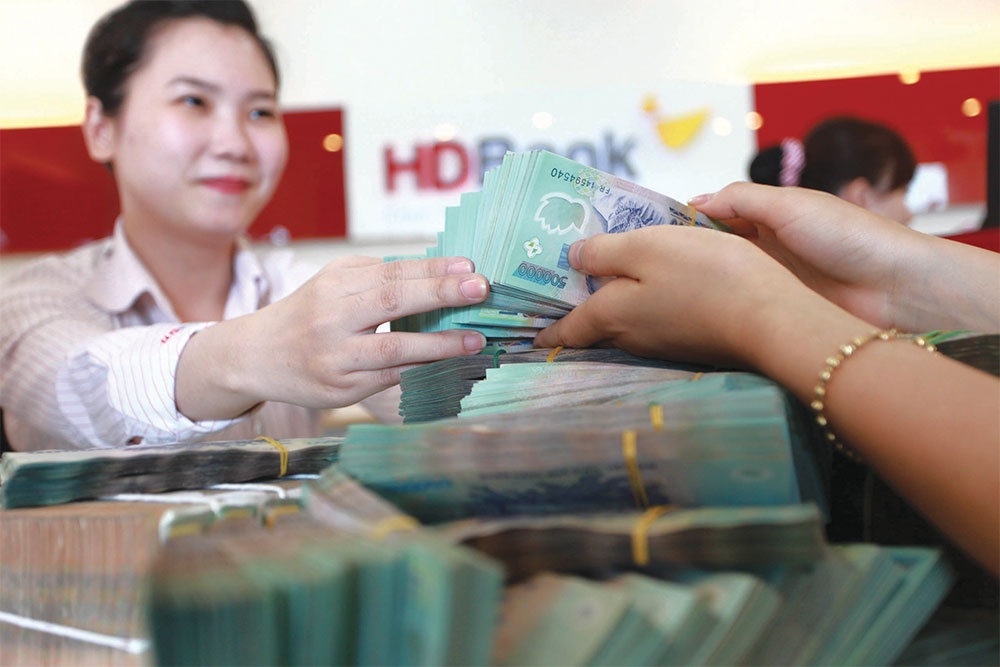Strategic plans in need for credit limits
November witnessed a modest decrease in the interest rates for capital mobilisation in Vietnam, predominantly ranging 0.2-0.4 per cent per annum across most terms in both state-owned and joint-stock commercial banks.
 |
| Strategic plans in need for credit limits, illustration photo |
For instance, state-owned Vietcombank adjusted its rates twice within the month, culminating in a reduction of approximately 0.3-0.4 per cent per annum. This brought the 12-month term rate down to a record low of 4.8 per cent per annum - approximately 0.5-0.6 per cent lower than its counterparts.
In the joint-stock banking sector, similar trends were observed. Most banks reduced their rates by around 0.1-0.4 per cent per annum.
Sacombank, notably, made a significant cut of 0.6 per cent per annum for terms extending beyond 12 months, aligning its rate with Vietcombank at 4.8 per cent per annum. Consequently, the average 12-month mobilisation rate has seen a significant decrease, resting 4.3-4.5 per cent per annum, a stark contrast to the rates at the start of the year.
A senior BIDV executive explained, “The downtrend in the VND capital mobilisation interest rates is supported by the State Bank of Vietnam’s (SBV) loose monetary policy, set against the backdrop of easing exchange rate pressures and controlled inflation. In fact, the new loan interest rates have returned to pre-pandemic levels, which is a significant achievement for the nation’s banking sector.”
Despite the sharp decline in interest rates, credit growth has accelerated compared to the previous month but has not seen a breakthrough when compared to the same period last year or in terms of capital mobilisation growth.
“The 9.15 per cent credit growth indicates that banks continue to finance the economy, predominantly through short-term lending, with normal capital turnover. This underscores the challenges in medium and long-term lending, largely due to external factors,” said Nguyen Thi Hong, Governor of the SBV.
In a recent meeting, Hong revealed that the SBV is reviewing and amending legal documents, emphasising the need to manage various risks tightly while easing difficulties. The SBV is also evaluating the overall process of managing credit growth limits, and currently considering whether to maintain or adjust them.
| Le Hoai An - Founder Integrated Financial Solutions In Vietnam’s financial arena, a distinct trend has emerged: banks are predominantly disbursing funds to large enterprises. To gauge the market’s capital absorption capacity, it’s imperative to examine the investment activities of publicly traded companies on the stock exchange. Data from 2023, compared to 2022, reveals a significant downturn in these firms’ investment activities. This downturn partly explains why there’s a belief that the new disbursements this year might be channelled more towards pre-emptive bond redemptions to offset cash flow shortages, rather than actual investment in business expansion. The debt profile of listed companies indicates a rise in short-term debts compensating for a decline in long-term liabilities. Credit growth in 2023, especially in the industrial and commercial sectors - traditionally the pillars of growth - has notably weakened. While these sectors experienced growth rates of 18-20 and 6-8 per cent, respectively, in December 2022, current rates have plummeted to approximately 13-14 and 4-5 per cent. On the brighter side, the construction sector shows signs of recovery from its 2022 lows, especially as real estate companies have received considerable funding since the year’s start, aiding in their business improvement. However, the outlook for the real estate and construction sectors remains uncertain due to persistently low consumer demand for real estate. Statistics from the Vietnam Real Estate Association show that in the first 10 months of the year, the absorption rate of new real estate offerings was below 20 per cent, significantly lower than in previous years. Despite maintaining high prices, the real estate market has not witnessed a corresponding demand, leading to a state of anticipation for a potential adjustment in 2024. The SBV remains committed to promoting credit growth and has approved additional credit limits for banks actively expanding their loan portfolios. This is accompanied by reduced lending rates to support the economy. |
 | The tools to withstand challenges in credit growth The ability to repay debt and collateral assets is currently a tough landscape. Economist Le Xuan Nghia talked to VIR’s Nhue Man about the prospects of abolishing credit limits in creating economic efficiency. |
What the stars mean:
★ Poor ★ ★ Promising ★★★ Good ★★★★ Very good ★★★★★ Exceptional
 Tag:
Tag:
Related Contents
Latest News
More News
- Stock market posts resilient 2025 performance (December 19, 2025 | 18:17)
- Citi Vietnam receives 2025 AmCham CSR recognition (December 19, 2025 | 16:35)
- As global green supply chain reshapes, will Vietnam be left behind? (December 19, 2025 | 08:00)
- Banks gear up for massive capital increases (December 18, 2025 | 17:04)
- Securing capital and efficiency for Vietnam’s 2026-2030 growth ambitions (December 17, 2025 | 10:00)
- Energy sector in need of blended finance mechanisms (December 17, 2025 | 09:00)
- Vietnam still has room to mobilise capital for sustainable growth (December 17, 2025 | 08:57)
- Long-term capital seen as key hurdle to green growth (December 16, 2025 | 08:00)
- Gold prices swing amid tax debate and import uncertainty (December 15, 2025 | 18:04)
- Agribank frames bank credit as catalyst for green growth (December 15, 2025 | 17:59)






















 Mobile Version
Mobile Version